This was published 8 years ago
Mount Cook National Park, New Zealand: Gliding by glaciers
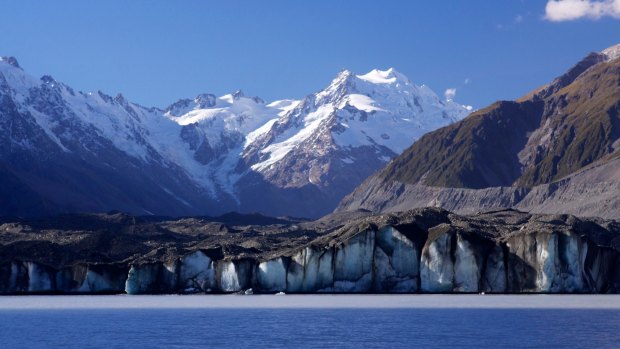
Mount Cook National Park. Credit: Alamy
Dan flicks the engine into neutral and we glide to a stop alongside a floating pyramid of dazzling white ice. When I reach to touch it, a piece breaks off, leaving me with a transparent fist-sized chunk. Dan says this iceberg carved off the Tasman Glacier a week ago and has since crystallised under the heat of the sun. The piece I'm holding is between 300 and 500 years old.
Normally, when people talk about glaciers and ice ages, the timescales involved are so vast they're impossible to comprehend. But here, in the heart of Mount Cook National Park in New Zealand's South Island, the pace of change is anything but glacial.
We're on Tasman Lake, the body of meltwater left behind by the Tasman Glacier as it slowly retreats up the valley under the watchful eye of Mount Cook. I say slowly but by glacier standards, it's practically sprinting. In the late 1990s it was receding by an average of 180 metres a year but it has since sped up dramatically and some experts predict New Zealand's longest glacier will disappear in our lifetime.
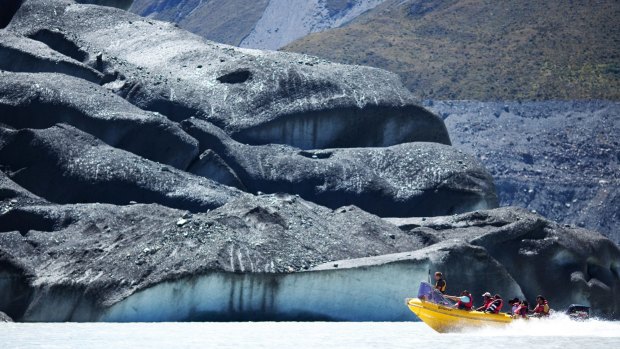
Mount Cook National Park and Tasman Glacier Lake, South Island New Zealand.Credit: Alamy
In one sense, this accelerated retreat is good news for Glacier Explorers, the company that operates this tour, because it means the glacier is more active than ever. Huge chunks of ice regularly carve off the face, forming spectacular icebergs that roll and change colour as they're heated by the sun.
However, it's sobering to think that 43 years ago you couldn't have done this tour because there wasn't a lake. In another 43 years, there might not be a glacier.
We leave the iceberg bobbing in our wake and speed across the lake to check out another. This one is rock hard and a striking sapphire blue. Dan explains that it rolled over during the night so the ice is still highly compressed. As it heats up, it will start to crystallise and turn white.
Huge chunks of ice regularly carve off the face.
I'm feeling a tad nervous about careering around an iceberg-riddled lake in what appears to be a bog-standard inflatable speedboat. We're all wearing life jackets but the water temperature is a heart-stopping 2 degrees and it's a long swim to shore.
As it turns out, this is far from a bog-standard speedboat. It's been custom-built by NZ specialist MAC Boats and has a solid, foam-filled polyethylene hull that is five times stronger than fibreglass. Impervious to osmosis and corrosion, it's virtually indestructible.
All of which makes me feel a little better as we approach a three-storey high monster of an iceberg. Dan says it carved off five weeks ago and has recently rebalanced, exposing rock and gravel that was once part of the valley floor. He's careful not to get too close as it's still unstable and could carve or roll at any time.
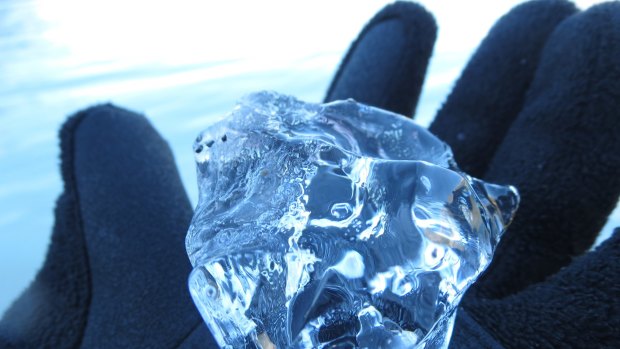
A fragment of an iceberg from Lake Tasman.Credit: Rob McFarland
The same applies to the face of glacier itself, which we admire from a safe distance of a couple of hundred metres. It's clear from the height of the lateral moraines – the piles of debris on either side of the glacier – that it's not only retreating up the valley but also reducing in height. As a result, it's covered in a dusting of rock and debris that's been left behind as the snow and ice have melted.
It's a spectacular sight, particularly when the sun comes out and the scene is framed by the impressive snow-capped peaks of NZ's two highest mountains – Mount Cook and Mount Tasman. That this magnificent spectacle might not be around for future generations is heartbreaking.
Of course, what most people on the tour are hoping to see is an iceberg carve off the face. And for the 16 people who were on the lake on February 22, 2011, that's exactly what they got. That was the day the now infamous 6.3-magnitude earthquake struck Christchurch, which in turn triggered a 1.2-kilometre-long block of ice to separate from the glacier. The 30-million-tonne slab crashed into the lake, creating a barrage of 3.5-metre-high tsunami waves that buffeted Glacier Explorers' boats for half an hour. Fortunately, no one was hurt, but as the saying goes – be careful what you wish for.
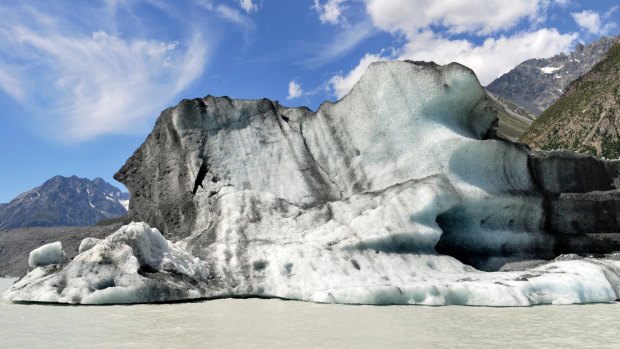
Icebergs on Tasman Lake, Mount Cook National Park. Credit: Alamy
TRIP NOTES
MORE INFORMATION
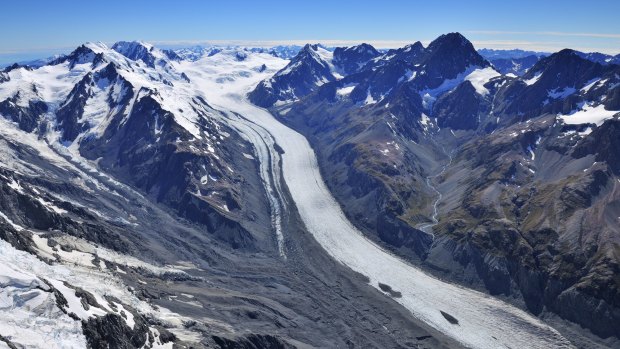
Tasman Glacier.Credit: Getty Images
GETTING THERE
Air New Zealand flies direct from Sydney and Melbourne to Christchurch and Queenstown. See airnewzealand.com.au.
GLACIER TOUR
Glacier Explorers operates this tour daily between early September and late May. Total duration including pick-up from Mount Cook Village is 2.5 hours. Adults $NZ155 ($144), children $NZ77.50 ($72). See glacierexplorers.com.
TOURING THERE
Adventure South's seven-day South Island multi-activity adventure includes this tour plus visits to Stewart Island, the Catlins, the Otago Peninsula and an overnight cruise on Doubtful Sound. Cost from $NZ3295 ($3000). Phone 1800 10 70 60, see advsouth.co.nz.
The writer travelled as a guest of Air New Zealand, Adventure South and Tourism New Zealand.
Sign up for the Traveller Deals newsletter
Get exclusive travel deals delivered straight to your inbox. Sign up now.